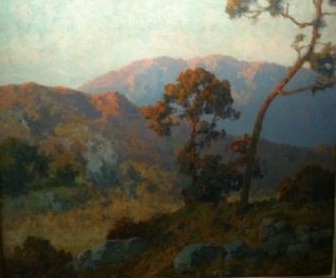
Maurice Braun
Hungarian, 1877-1941 (active USA)
Evening Light no. 2, n.d.
Oil on canvas
20 x 24"

Photograph of Maurice Braun in his studio, n.d.
"Let us remember that method, style, subject and all the rest are merely the clothing in which the thing itself, 'Art', is enclosed ... It is the aroma of the message that is important ... Let the real aim of art and purpose of the student who wishes to penetrate the mysteries of art be, therefore, the achievement of inner vision." - Maurice Braun
COMMENTS
In 1909, an established New York figure and portrait painter, Braun found portraiture too constraining artistically and he left for California to escape the influence of other artists working in the area. He became a pioneer od western American art and achieved renown as a respected landscape painter.
As an early California artist, Braun was inspired to interpret the state's natural landscape. Southern California offered many new opportunities. The colors and forms of the region were a revelation. Brown grasses, blue mountains, and rugged rock formations were to provide endless challenges relative to the interplay of light and color with the artist's strong sense of composition. Braun was captivated by the area. He repeated the landscape frequently, always seeking a new interpretation of mood and expression.
Braun's landscapes became known for their "impressionistic" and "decorative qualities" as art writers emphasized the significance of the artist's "close study of outdoor effects of light." The light and airy style reminiscent of French Impressionism and of his own teacher, William Merritt Chase, may have influenced Braun. His sympathy for the California scene he attributed to the appeal of "its bigness, its richness and its optimism."
Braun's paintings were vehicles for spreading the image of the familiar eucalyptus trees gracing the Southern California area. "Where a tree appears in his landscape it is nearly always characteristically the Eucalyptus which in his California work lends itself to such a great variety of effect and mood, an indication that, like the Oak in New England and English landscape, the Eucalyptus will endear itself as typically California." Undoubtably Braun contributed, although not exclusively, to the establishment of that imagery as a part of the Southern California pictorial vocabulray.
- Martin E. Petersen, "Second Nature: Four Early San Diego Landscape Painters"
